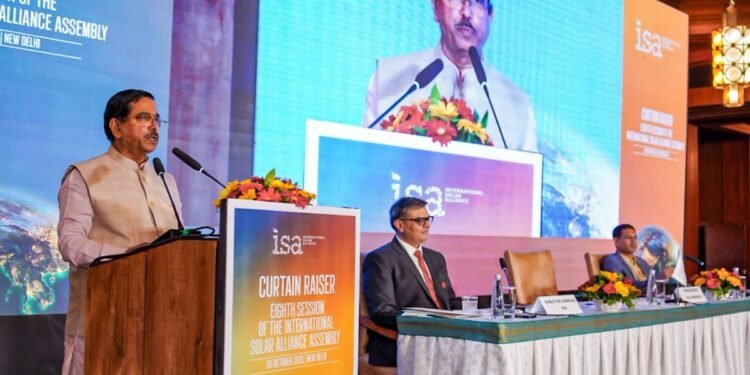NEW DELHI, India: With climate negotiations gaining momentum ahead of COP30 in Brazil, the International Solar Alliance (ISA) on Wednesday hosted the curtain-raiser for its Eighth Assembly, scheduled from October 27 to 30 at Bharat Mandapam in New Delhi. The event brought together diplomats, minister, and energy leaders from across continents to reaffirm a shared vision of making solar power the backbone of global clean energy transition.
Launched jointly by India and France at COP21 in Paris, the ISA has grown into the largest treaty-based intergovernmental organization from the Global South, uniting 124 member and signatory countries. The upcoming Assembly will seek to translate collective ambition into measurable action focusing on catalytic finance, technology innovation, digital transformation, and regional collaboration to scale up solar energy worldwide.
Speaking at the event, Union Minister for New and Renewable Energy and ISA Assembly President Pralhad Joshi highlighted India’s leadership in the global energy transition.
“India achieved its renewable energy targets five years ahead of schedule, with over 50 percent of its power capacity now sourced from non-fossil fuels. With 125 GW of installed solar capacity, India is the world’s third-largest solar producer. But beyond numbers, our journey reflects how clean energy can transform lives bringing light to rural homes, powering health centers, and strengthening agriculture,” he said.
Joshi noted that flagship initiatives such as PM SuryaGhar “Muft Bijli Yojana” (Free Electricity Scheme) and PM-KUSUM are bridging the urban-rural energy divide by enabling decentralized solar adoption. Over two million households have already benefited from rooftop solar installations, while millions of agricultural pumps are being solarized to ensure sustainable irrigation.
Shri Santosh Kumar Sarangi, Secretary, Ministry of New and Renewable Energy, underlined that India now ranks third globally in renewable capacity and second in solar manufacturing, next only to China. “India’s clean energy strategy is no longer limited to generation—it now encompasses the entire value chain, from manufacturing solar modules to pioneering green hydrogen, where we aim to produce five million tonnes annually by 2031,” he said.
Sarangi also emphasized the ISA’s growing role in facilitating experience-sharing and collaborative deployment among developing nations. “India will continue to extend both financial and technical support, particularly in Africa and among Small Island Developing States (SIDS), where solarization efforts are showing tangible progress,” he added.
ISA’s Director General Ashish Khanna said the world’s energy equation is changing faster than ever.
“It took oil 25 years to reach 1,000 GW of capacity. Renewables achieved that in just two. For the first time, global renewable generation has surpassed fossil generation. The Global South now has an opportunity to lead this transition, and the ISA will serve as the platform that converts commitments into real projects and measurable impact,” he said.
Khanna reiterated Prime Minister Narendra Modi’s “One Sun, One World, One Grid” (OSOWOG) vision, which aims to connect energy grids across continents, enabling nations to share sunlight as a common resource. He also announced that India’s upcoming Global Capability Centre (GCC)—linked with STAR-C hubs around the world—will act as a digital and technical backbone for training, data sharing, and solar innovation.
The Assembly will focus on four strategic pillars, the Catalytic Finance Hub, Global Capability Centre and Digitization, Regional and Country-Level Engagement, and Technology & Policy Roadmaps. Discussions are expected to spotlight solar for agriculture, floating solar, AI-based energy planning, and green hydrogen as key enablers of next-generation clean energy systems.
Two flagship reports Ease of Doing Solar 2025 and Solar Trends 2025—will also be launched, assessing global progress and policy pathways for accelerating solar deployment.
In the run-up to the Assembly, ISA convened Regional Committee Meetings in Brussels, Colombo, Santiago, and Accra, engaging over 100 countries to align national actions with ISA’s global framework. The recommendations from these meetings—focused on financing innovation and expanding solar access—will feed directly into the New Delhi Assembly’s outcomes.
Solar Diplomacy and the Global South’s Moment
The International Solar Alliance, established in 2015 by India and France, has become a diplomatic bridge between the developed and developing worlds, promoting solar as a unifying force for sustainable growth. By pooling demand, harmonising technology standards, and unlocking climate finance, ISA has helped bring clean energy within reach for many nations in Africa, Asia, Latin America, and the Pacific Islands.
As the world prepares for COP30, where nations will negotiate the next phase of global climate commitments, ISA’s New Delhi Assembly is being seen as a crucial agenda-setter for the Global South—where solar energy is not just an environmental solution but a tool for equity, resilience, and economic sovereignty.
In a world still divided by access to technology and finance, the ISA represents a rare convergence, an effort to ensure that the energy of the future shines equally on all.
– WNN Desk



















